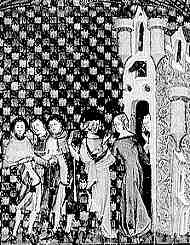
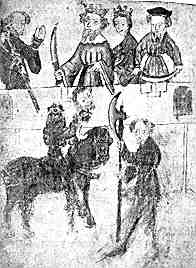
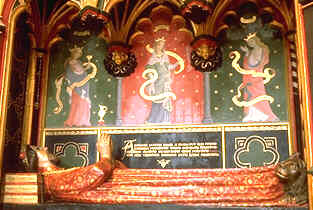
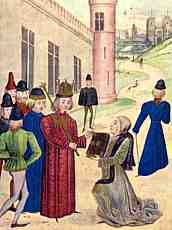
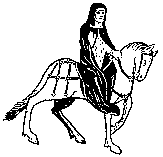
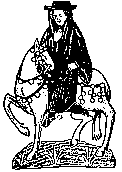
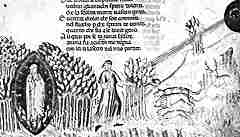
If you are looking at this page without frames, there is more information about medieval writing to be found by going to the home page (framed) or the site map (no frames).
| Poetry (2) | |||||||
| Many of the tales of romance that were written in prestige editions for the wealthy aristocratic laity were in verse. This must reflect, in part, their origins in the oral tradition when wandering minstrels would recite and sing these tales for the delight of their audiences. A form that included aids to memory may also have made it easier for the developing literacy of these upper class patrons. These works demonstrate the existence of something that was common in the medieval literary and oral tradition but now rare in our literate culture; the use of poetry in a long work to tell a story. | |||||||
 |
Volumes of romance were lavishly produced for their upper class buyers and patrons, and they reflected themselves in them, most notably in the illustrations. It is intriguing that the ballad hero of the less elevated social classes, Robin Hood, does not appear in manuscript form, but only materialises from the oral tradition in the early days of printing, as literacy moved socially downmarket. | ||||||
| Segment from a miniature from a 14th century copy of the Romances of Alexander, depicting exquisite 14th century aristocrats outside their castle (Bodleian Library, MS Bodley 264, f.164b). (From The New Palaeographical Society 1906) | |||||||
| The relationship between romance and ballad, literate and oral tradition, is difficult to elucidate with so many pieces of the puzzle lost. Some works are known from very few manuscript copies and it might be hard to determine whether a particular poetic work is essentially an oral work written down, or a literary work nearly lost. The famous poem Sir Gawain and the Green Knight is set in the Arthurian romance tradition and embedded in chivalric values. It is also written in a midland dialect of English and contains some robust rural and folkloric imagery. It is known from only one manuscript. The relationship between oral and written storytelling poetry of the middle ages may be quite complex. |
 |
||||||
| An unfortunately scruffy image of a miniature of the 14th century manuscript of Sir Gawain and the Green Knight (British Library, Cotton Nero A X). | |||||||
| In the above image, the drawing of the figures is more quaint than exquisite. The Green Knight, on his horse, has just had his head lopped off in the middle of King Arthur's feasting hall and is about to gallop off into the badlands, shouting challenges for a return bout. I can't wait until they bring out the movie! | |||||||
| Further discussion on the imagery in Sir Gawain and the Green Knight can be found in articles by Ralph Elliott and Tania Colwell in the collection of essays Our Medieval Heritage, published in 2002 by Merton Priory Press. | |||||||
| Not all long poems were ripping yarns. Extended works like Le Roman de la Rose or Piers Plowman combined allegory and moral teaching with a story, the function of which was not simply to entertain. Poetic forms were not simply the rollickings of minstrels written down, but a self-conscious art tradition, very often with moral overtones. Nor were the works all compilations from anonymous authors; a concept beloved of the folk tradition. While we may not know much about the lives of authors like Chrétien de Troyes or Langland, and while their work appears in manuscripts in different variant editions, this does not mean that the authors were fictional or themselves a compilation of folklore. The process of manual transcription of works, one copy at a time, gives rise to multiple variations as copyists omit, embellish or vary the text. That does not make the original author either anonymous or fictitious. | |||||||
| There are some studies of this process on the web. The Charrette Project examines multiple texts of Chrétien de Troyes Arthurian romance Le Chavalier de la Charrette. The Piers Plowman Electronic Archive has begun the process of examination of variant texts of Langland's work while Le Roman de la Rose examines the text of various manuscripts of that work. | |||||||
 |
The restored tomb of poet John Gower in Southwark Cathedral London. | ||||||
| Medieval poets received recognition as individuals in their own time. The tomb of moralist and satirist John Gower has been lavishly, some might say garishly, restored in what is now the cathedral church of Southwark, in London. It was, however, a splendid and noteworthy thing in its own time. The poet's head rests on three books, leaving no doubt as to the attribute that earned him lasting commemoration. | |||||||
| While those of a religious persuasion might have their authorial activity supported by the church that gave them bed and board, the lay poets of the later middle ages had to find some way to support their habit. No copyright laws meant that once the work was out there, any passing scribe could copy it and pass it on. The 15th century poet Hoccleve, for example, plodded along with the drudgery of a chancery clerk in between his literary endeavours. A wealthy patron could provide more scope for the artistic temperament. Elaborate volumes sometimes contain miniatures of the poet presenting his work to an influential patron, often with a bit of religious imagery around to emphasise the benefit this philanthropy has brought to the patron's soul. |  |
||||||
| Froissart presents his volume of love poetry to King Richard II. | |||||||
| The two giants of vernacular literature of the 14th century, Chaucer and Dante, produced their very different types of literary work in verse. In his Canterbury Tales, Chaucer used the poetic mode to tell stories that were sometimes social observation, sometimes moral, but had elements of yarn spinning and bawdry that brought them out of the rarified space of intellectual or spiritual puzzles for the intelligentsia. One can imagine a spirited raconteur giving a rendition around an alehouse fire. | |||||||
 |
Chaucer's prioress and monk on their way to Canterbury. |
 |
|||||
| Dante's Divine Comedy takes its readers on the ultimate spiritual journey from the depths of hell to the heights of heaven. While it has a story, it is difficult to imagine it as other than a text for the literate reader to study and contemplate; a reader's poem rather than a performer's piece. It utilises an intricate and precise system of rhyme throughout its great length, causing pain to translators who have either tortuously reproduced it, or ignored it in the interest of accurate rendition of sense, thereby diminishing the work's original poetic qualities. |
 |
||||||
| Dante sets out on his journey in a 14th century Italian copy of the work (British Library, add. ms. 19587), by permission of the British Library. | |||||||
| The term poetry, therefore, encompasses a range of techniques and literary forms in the medieval tradition. | |||||||
|
|
|||||||
|
|
|||||||
|
If you are looking at this page without frames, there is more information about medieval writing to be found by going to the home page (framed) or the site map (no frames). |
|||||||